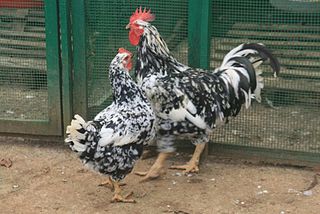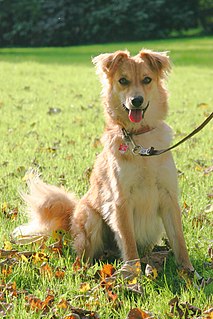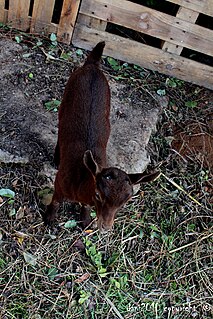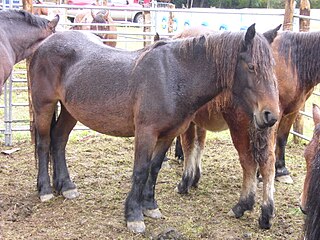Related Research Articles

The Merino is one of the most historically relevant and economically influential breeds of sheep, much prized for its wool. The origins of the breed are the subject of debate, with alternatives of it originating in flocks transferred from Morocco as early as the 12th century, originating and being improved in Extremadura in southwestern Spain, in the 12th and 13th centuries or from the selective crossbreeding of Spanish ewes with imported rams at several different periods. It was instrumental in the economic development of 15th and 16th century Spain, which initially held a monopoly on the trade in its wool. Since the end of the 18th century, the breed was further refined in New Zealand and Australia, giving rise to the modern Merino.

The Azteca is a horse breed from Mexico, with a subtype, called the "American Azteca", found in the United States. They are well-muscled horses that may be of any solid color, and the American Azteca may also have Paint coloration. Aztecas are known to compete in many western riding and some English riding disciplines. The Mexican registry for the original Azteca and the United States registries for the American Azteca have registration rules that vary in several key aspects, including ancestral bloodlines and requirements for physical inspections. The Azteca was first developed in Mexico in 1972, from a blend of Andalusian, American Quarter Horse and Mexican Criollo bloodlines. From there, they spread to the United States, where American Paint Horse blood was added.

The Alano Español or Spanish Alano is a Spanish breed of large dog of molossoid type. The dogs have been used as cattle catch dogs, hunting, and guarding. It was formerly use during Spanish bullfights, and is sometimes called the Spanish Bulldog in English.

The Pita Pinta Asturiana is the only breed of chicken indigenous to the principality of Asturias, in north-western Spain.

The Sayaguesa is an endangered Spanish breed of domestic cattle. It is named for the comarca of Sayago in the province of Zamora, in the western part of the autonomous community of Castile and León, and is raised almost exclusively in that area. It may also be known as the Zamorana, the Moles de Sayago or the Castellana variedad Sayaguesa. It was traditionally kept mainly for draught work, but is now raised principally for meat.

The Basque Shepherd Dog, Basque: Euskal Artzain Txakurra, Spanish: Perro de Pastor Vasco, is a traditional Spanish breed of sheepdog originating in the historic Basque Country. It is believed that they originated from Central European herding dogs.

Asturian Mountain is a local Spanish breed of cattle, which possess breeding capacity and docility. They are primarily raised in the east of Asturias, in the north of Spain, particularly in the mountain range of the Picos de Europa, including within the National Park of Covadonga. The breed is also known as the Casina They are beef cattle and one of three breeds used to produce Casín cheese.

The Pachón Navarro is a Spanish breed of hunting dog from the autonomous community of Navarre, in northern Spain. It is one of five Basque breeds of dog, the others being the Basque Shepherd Dog, the Erbi Txakur, the Villano de Las Encartaciones and the Villanuco de Las Encartaciones.

The Murciano-Granadina is a Spanish breed of dairy goat. It was created in 1975 when two existing breeds, the mahogany-coloured Murciana of Murcia and the black Granadina of Granada, began to be hybridised as a result of the official recognition of a single herdbook including both breeds. It is the most important dairy goat breed of Spain, with more than 500,000 milking females. It originated in the semi arid areas in south eastern Spain, including parts of Murcia, Almería, Granada and Alicante. They were bred for two main traits, milk production and its ability to continue this production in dry and nutrient poor regions. They have been introduced into several areas in Latin America as well as northern Africa.

There are a number of Basque breeds and cultivars. These are domesticated animals that have been bred - or plant species cultivated - for particular traits and features by Basque people in the Basque Country.

Asturian Valley cattle originate from the valleys of Asturias, Spain. They are mostly raised in the northern coastal areas on the Bay of Biscay and the river valleys at the foot of the Cordillera Cantábrica mountain range. This breed belongs to an exclusive bovine group in Spain known as the tronco Cantábrico that only includes breeds native to northern Spain; it also includes the Asturian Valley cattle. of all those breeds, Asturian Valley maintain the largest number. Traditionally the cattle were used for milk, meat, and work. Since other milk breeds have been introduced to Spain, their prominence has declined in the dairy industry. They remain one of three breeds that may be used to produce Casín cheese.

The Asturcón is an ancient breed of small horse or pony from the autonomous region of Asturias in northern Spain. It has been documented since Roman times: it has an unusual ambling gait, which was described by Pliny the Elder in his Naturalis Historia. It is of Celtic type, and shows similarity to the Pottok and Losino of Spain, the Garrano of Portugal, and the Dartmoor, Exmoor, Fell, Highland, Shetland and Welsh breeds of the British Isles.

The Jaca Navarra, or Navarrese Horse, is a breed of small horse from the Navarre region of northern Spain. It is listed in the Catálogo Oficial de Razas de Ganado de España in the group of autochthonous breeds in danger of extinction. The total population of the Jaca Navarra has been variously estimated at 350, 250, and 240 and decreasing. In April 2011 the total population was reported to be 899, all of which were in Navarre. The breed is listed by the FAO as Endangered.

The Zamorano-Leonés is a breed of large domestic donkey from the provinces of Zamora and León, in the autonomous community of Castilla y León, in north-western Spain. The name derives from those of the two provinces.
The Fariñeiro or Galician: 'Burro Fariñeiro' is a breed of small domestic donkey indigenous to the autonomous community of Galicia, in north-west Spain. Its name derives from its former use as a pack animal to transport sacks of flour. It may also be referred to as the Spanish: 'Asno Gallego'. It does not have official recognition, and its numbers are severely reduced. It is found mainly in the Península del Morrazo in the province of Pontevedra, in the area surrounding Betanzos in the province of A Coruña, in the comarcas of the los Ancares and O Caurel areas of the province of Lugo and in the mountains of the province of Ourense.

The Castellana Negra or Gallina Castellana Negra is a Spanish breed of domestic chicken. It is a good egg-laying breed, rustic and disease-resistant. It was formerly widely kept and commercially exploited in Spain. Since the advent of imported commercial hybrid layer chickens and the spread of highly intensive chicken farming methods, it has almost disappeared.

The Euskal Oiloa, Spanish: Gallina Vasca, is a breed of domestic chicken from the autonomous community of the Basque Country in north-eastern Spain and south-western France. It is the traditional rural chicken of the area, a rustic dual-purpose breed of Atlantic type, and differs from Mediterranean Spanish breeds such as the Castellana Negra and the Minorca in several respects: it has yellow legs and feet, red earlobes, and lays brown eggs.

The Palmera is an endangered breed of cattle from the island of San Miguel de La Palma, in the Spanish autonomous community of the Canary Islands. The cattle are not indigenous to the island, but were brought by European settlers in the fifteenth century. The Palmera derives from the Rubia Gallega breed of Galicia. It is distributed mostly in the municipalities of Breña Alta, Breña Baja, El Paso, Garafía, Los Llanos de Aridane and Villa de Mazo, with small numbers in the municipalities of Puntagorda, Santa Cruz de La Palma and Tijarafe; a few may be found on the islands of Fuerteventura and Tenerife.

The Xalda is an endangered breed of sheep indigenous to the Asturias province of Northern Spain.
The Spanish Trotter, Spanish: Trotador Español, is the national breed of trotting horse of Spain. It is reared almost exclusively in the Balearic Islands in the Mediterranean, predominantly in the island of Mallorca, but also in Menorca and Ibiza.
References
- 1 2 "Asociacion Nacional de Criadores de Raza Guirra". Guirra (in Spanish). Asociacion Nacional de Criadores de Raza Guirra. Retrieved 2014-07-29.
- ↑ Schoenian, Susan. "Guirra". Sheep Breeds G - I. Sheep101.info. Retrieved 2014-07-29.